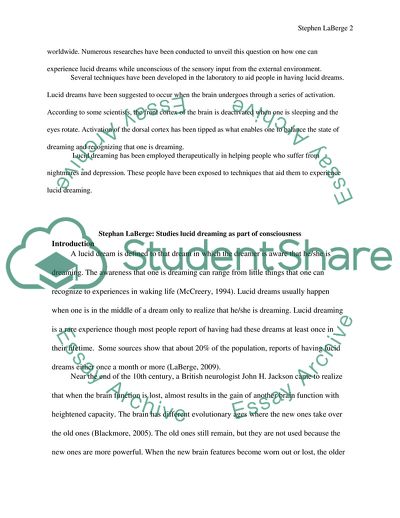Cite this document
(Stephan LaBerge studies lucid dreaming as part of consciousness (how Coursework - 1, n.d.)
Stephan LaBerge studies lucid dreaming as part of consciousness (how Coursework - 1. https://studentshare.org/psychology/1790136-stephan-laberge-studies-lucid-dreaming-as-part-of-consciousness-how-can-we-be-conscious-of-the-fact-that-we-are-dreaming-while-we-are-unconscious-of-sensory-input-from-the-environment
Stephan LaBerge studies lucid dreaming as part of consciousness (how Coursework - 1. https://studentshare.org/psychology/1790136-stephan-laberge-studies-lucid-dreaming-as-part-of-consciousness-how-can-we-be-conscious-of-the-fact-that-we-are-dreaming-while-we-are-unconscious-of-sensory-input-from-the-environment
(Stephan LaBerge Studies Lucid Dreaming As Part of Consciousness (how Coursework - 1)
Stephan LaBerge Studies Lucid Dreaming As Part of Consciousness (how Coursework - 1. https://studentshare.org/psychology/1790136-stephan-laberge-studies-lucid-dreaming-as-part-of-consciousness-how-can-we-be-conscious-of-the-fact-that-we-are-dreaming-while-we-are-unconscious-of-sensory-input-from-the-environment.
Stephan LaBerge Studies Lucid Dreaming As Part of Consciousness (how Coursework - 1. https://studentshare.org/psychology/1790136-stephan-laberge-studies-lucid-dreaming-as-part-of-consciousness-how-can-we-be-conscious-of-the-fact-that-we-are-dreaming-while-we-are-unconscious-of-sensory-input-from-the-environment.
“Stephan LaBerge Studies Lucid Dreaming As Part of Consciousness (how Coursework - 1”. https://studentshare.org/psychology/1790136-stephan-laberge-studies-lucid-dreaming-as-part-of-consciousness-how-can-we-be-conscious-of-the-fact-that-we-are-dreaming-while-we-are-unconscious-of-sensory-input-from-the-environment.


